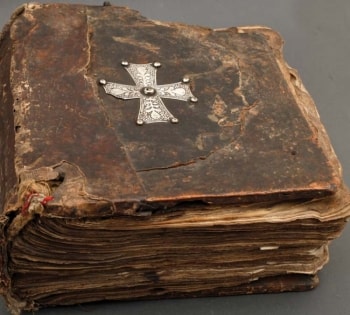Adysh Gospels

The Adysh Gospels is one of the oldest monuments of Georgian writing and literary language, which was discovered in the church of the village Adishi and is currently preserved in the Svaneti Museum of History and Ethnography.
According to the three systems of chronology mentioned in the colophon of the manuscript, the Adysh Gospels were copied by a certain writer Michael in 897 at the Shatberdi Monastery, which was founded by Gregory of Khandzta, on the order of the great Sophron, the renovator of the monastery; Bookbinding was done by Michael the Deacon. The manuscript is written in Asomtavruli alphabet in two columns on a parchment (30 X 25 cm). The first five pages convey the Ten Canons of Eusebius. The ancient Georgian translation of the Adysh Gospels is preserved in the manuscript, it was copied from the older Hermetic texts. The Adysh Gospels stands apart editorially from other Opiza variant of manuscripts of the ancient four Gospels. An exception is the part of the Gospel of Luke, which the transcriber copied and filled in from the manuscript of the Opiza edition due to the lack of the Hermetic text in this section. The Adysh Gospels are very noteworthy in terms of grammatical, especially syntactic, as well as lexical and terminological structure, dialecticisms and foreign language elements. In the 2nd half of the 15th century, the Adysh Gospels along with other manuscripts were taken by Nikolaos, the former abbot of the Jumati Monastery in Guria, but the manuscript did not stay in Guria for long and was taken to Svaneti, which is confirmed by the Nuskhuri and Mkhedruli inscriptions of the 16th–17th centuries.
The first reference to the Adysh Gospels belongs to I. Bartolomei, the second one to B. Nizharadze (Free Svan), later — P. Uvarova, A. Khakhanashvili, E. Takaishvili, A. Shanidze and others. During the expedition organized by E. Takaishvili in 1910, D. Ermakov took photos of all pages of the Adysh Gospels (200 tables) and on its basis a phototype album with E. Takashvili's extensive research was published by the Moscow Archaeological Society (in the series: Материалы по археологии Кавказа, XIV, 1916).
R. Blake, professor of Harvard University, published the text of the Adysh Gospels (with the variants of the Opiza and Tbet' gospels and Latin translation) on the basis of this publication: Gospel of Mark — 1928, Gospel of Matthew — 1933, Gospel of John —1950 (with M. Brière) and Gospel of Luke — 1955 (published by M. Brière). A. Shanidze published the text of the Adysh Gospels along with the Four Gospels of Jruchi and Parkhali (Two old editions of Georgian Four Gospels in accordance with three Shatberdi manuscripts, 1945).
Literature: გონიაშვილი თ., დიალექტიზმებისათვის ჰადიშის ძეგლში, «ენიმკის მოამბე», 1938, ტ. 4, ნაკვ. 2; დოჩანაშვილი ელ., მასალები ადიშის ოთხთავის წარმომავლობის საკითხისათვის, «მასალები საქართველოს და კავკასიის ისტორიისათვის», 1955, ნაკვ. 32; იმნაიშვილი ი., ადიშის ოთხთავი რედაქციულად, «თსუ შრომები», 1947, ტ. 30 В-31 В; ყაუხჩიშვილი ს., ადიშის ხელნაწერის ბერძნიზმები, «ენიმკის მოამბე», 1944, ტ. 14; შანიძე ა., ჰაემეტობა ადიშის სახარებაში უძველესი ქართული ტექსტების აღმოჩენის გამო, «ტფილისის უნივერსიტეტის მოამბე», 1922–23, ტ. 2.
K. Danelia


